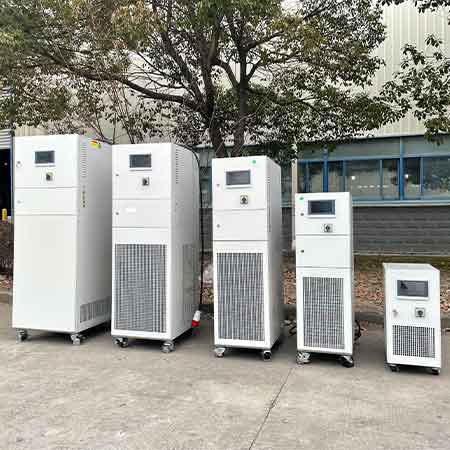Heat Transfer Fluid Heater
完璧な温度制御ソリューションについては、今すぐお問い合わせください。
Structure of heat transfer fluid heater
According to the structure, the types of heat transfer fluid heaters can be divided into tube type and plate type.
1. Plate heat exchanger is a channel composed of plates separated by a certain distance and pressed by sealing gaskets. Hot and cold media, two fluids with a temperature difference, will enter the plate channel from the corner holes through convection heat transfer. Whether the fluid direction of the adjacent channel is countercurrent or downstream, heat will be exchanged through the plate.
2. Tubular heat exchangers are made of multiple layers of materials with good thermal conductivity. The working principle is similar to that of water heaters. Tubular heat exchangers are mainly composed of shells, tube bundles, tube sheets and heads. The shells are mostly in the shape of It is round and equipped with parallel tube bundles inside, and both ends of the tube bundle are fixed on the tube plate.
3. Tubular heat exchangers are mainly composed of shells, tube bundles, tube sheets and heads. The shells are mostly round, with parallel tube bundles inside, and both ends of the tube bundle are fixed on the tube sheets.

Heat transfer fluid heaters are classified according to their uses
Heat exchangers are used in industry as heaters, preheaters and superheaters.
1. When used as a heater, heat the fluid to the necessary temperature.
2. Preheater to preheat the fluid.
3. Superheater, which heats fluid or steam to a superheated state.
Heat transfer fluid heaters are classified according to heat transfer principles
A heat transfer fluid heater is a device that transfers part of the heat of a hot fluid to a cold fluid. A large sealed container is filled with water or other media, and a pipe passes through the container, allowing two media with different temperatures to flow from the pipe. However, due to the temperature difference between the hot water in the pipe and the cold and hot water in the container, heat exchange will occur.
According to the heat transfer principle, it can be divided into surface heat transfer, heat storage type, fluid connection indirect and direct contact.
1. Surface heat transfer type
Surface heat exchangers are two fluids with different temperatures flowing in a space separated by a wall. Through the heat conduction of the wall and the convection of the fluid on the wall surface, heat is exchanged between the two fluids. Surface heat exchangers include shell and tube, sleeve and other types of heat exchangers.
2. Regenerative type
The regenerative heat exchanger transfers heat from high-temperature fluid to low-temperature fluid through a regenerator made of solid material. The hot medium first reaches a certain temperature by heating the solid material, and then the cold medium is heated by the solid material to reach a certain temperature. purpose of delivery. Regenerative heat exchangers include rotary type, valve switching type, etc.
3. Indirect fluid connection
Fluid connection indirect heat exchanger is a heat exchanger that connects two surface heat exchangers by a heat carrier circulating in them. The heat carrier circulates between the high-temperature fluid heat exchanger and the low-temperature fluid. When the high-temperature fluid receives Heat is released to the low-temperature fluid in the low-temperature fluid heat exchanger.
4. Direct contact heat exchanger
Direct contact heat exchanger is a device in which two fluids are in direct contact for heat exchange, mainly cooling water towers and gas condensers.
温度制御システムの設計から製造まで一貫して行います。標準モデルから完全なカスタマイズ製品まで 900 .私たちはカスタマーサービスに特化し、お客様一人ひとりのニーズに合った最適な温度制御システムを提供することに専念しています。
私達は標準外カスタマイズされた解決を提供します。単一の冷却のスリラーおよび冷却及び暖房のコンボの単位は両方利用できます。
Eメール info@lneya.com WeChat ID: +8615251628237 WhatsApp: +86 17851209193
 LNEYA
LNEYA
 简体中文
简体中文


















































































